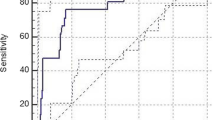Abstract
This work involves a retrospective analysis of serum amylase, lipase, and lipase/amylase ratio in alcoholic and nonalcoholic patients diagnosed with acute pancreatitis. The purpose of this study was to test the reliability of the Dupont ACA method with respect to the lipase/amylase ratio as a discriminator, for the etiology of pancreatitis. Thirty-six consecutive patients with the diagnosis of acute pancreatitis were studied. These patients were divided in two groups. Group I consisted of 11 patients who had presumed acute alcoholic pancreatitis. In group II, 19 patients had acute biliary pancreatitis, including two with necrotizing pancreatitis and abscess formation secondary to cholilathiasis, five cases were idiopathic in nature, and one was thought to be medication induced (hydrochlorothiazide). In all cases, the Dupont ACA discrete clinical analyzer was used to determine serum levels of amylase and lipase. Concerning the lipase/amylase ratio, the geometric mean ratio for group I was 0.32 (range: 0.11–0.86) and for group II the mean ratio was 0.22 (range: 0.04–0.93). WithP>0.1, the difference between geometric mean ratios was not statistically significant. This study reveals that the lipase/amylase ratio would not have been a good indicator of alcoholic vs nonalcoholic acute pancreatitis. Although there was no significant statistical difference between geometric means, this study does show a significant difference in the number of individuals with serum amylase >2000 IU/dl in nonalcoholic acute pancreatitis patients (8/25 showed levels above 2000 IU/dl) when compared to alcoholic acute pancreatitis patients (0/11 showed levels above 2000 IU/dl). Chi-square analysis between <2000 IU/dl and >2000 IU/dl for the nonalcoholic vs the alcoholic groups yielded aP value of 0.03.
Similar content being viewed by others
References
D'emden MC, Wong L, Harris DD: Serum amylase, isoamylase and lipase in acute alcoholism. Aust NZ. J Med 14:819–821, 1984
Salt WB, Schenker S: Amylase, its clinical significance: A review of the literature. Medicine 55:269–289, 1976
Gumaste VV, Sereny G, Dave P, Bhandway A, Gumaste S: Serum lipase levels in chronic alcoholics. J Clin Gastroenterol 13:407–410, 1991
Van Gossum A, Seferian V, Rodzyneck JJ, et al: Early detection of biliary pancreatitis. Dig Dis Sci 29:97–101, 1984
Blamey SL, Osborne DH, Gilmour WH, et al: The early identification of patients with gall stone-associated pancreatitis using clinical and biochemical factors only. Ann Surg 198:574–578, 1983
Gumaste VV, Dave PB, Weissman D, Messer J: Lipase/amylase ratio. Gastroenterology 101:1361–1366, 1991
Tenner SM, Steinberg W: The admission serum lipase/amylase ratio differentiates alcoholic from non alcoholic acute pancreatitis. Am J Gastroenterology 87:1755–1758, 1992
Pezzelli R, Billi P, Miglioli M, Gullo L: Serum amylase and lipase concentrations and lipase/amylase ratio in assessment of etiology and severity of acute pancreatitis. Dig Dis Sci 38:1265–1269, 1993
King GL, Seelig CB, Ranney JE: The lipase to amylase ratio in acute pancreatitis. Am J Gastroenterol 90:67–69, 1995
James GP, Passey RB, Fuller JB, Giles ML, Gadsden RH, Phelps CE, Hastie EC, Porter WH, Wenk RE, Paherson D: An evaluation of an amylase method for the Dupont ACA, Dupont Company, Wilmington, Delaware, April 1976.
Supplementary information pertaining to the effects of various drugs and patient conditions onin vitro diagnostic levels can be found in drug interferences with clinical laboratory test. Clin Chem 21:5, 1975
Vogel WC, Zieve L: A rapid and sensitive turbidimetric method for serum lipase based upon differences between the lipases of normal and pancreatitis serum. Clin Chem 9:168–181, 1963
Shihabi ZK, Bishop C: Simplified turbidimetric assay for lipase activity. Clin Chem 17:1150–1153, 1971
Verduin PA, Punt JMHM, Krentzer HH: Studies on determination of lipase activity. Clin Chem Acta 46:11–19, 1973
Agarwal N, Pitchumonia CS, Sivaprasad AV: Evaluating tests for acute pancreatitis. Am J Gastroenterol 85:356–366, 1990
Strum WB, Spiro HM: Chronic pancreatitis. Ann Intern Med 74:264–277, 1971
Renner IG, Savage WT, Pantoja J, Renner VJ. Death due to acute pancreatitis—a retrospective analysis of 405 autopsy cases. Dig Dis Sci 30:1005–1018, 1985
Nordestgard AG, Wilson SE, Williams RA: Correlation of serum amylase levels with pancreatic pathology and pancreatic etiology. Pancreas 3:159–162, 1988
Author information
Authors and Affiliations
Rights and permissions
About this article
Cite this article
Ansari, E., Talenti, D.A., Scopelliti, J.A. et al. Serum lipase and amylase ratio in acute alcoholic and nonalcoholic pancreatitis by using Dupont ACA discrete clinical analyzer. Digest Dis Sci 41, 1823–1827 (1996). https://doi.org/10.1007/BF02088753
Received:
Accepted:
Issue Date:
DOI: https://doi.org/10.1007/BF02088753




